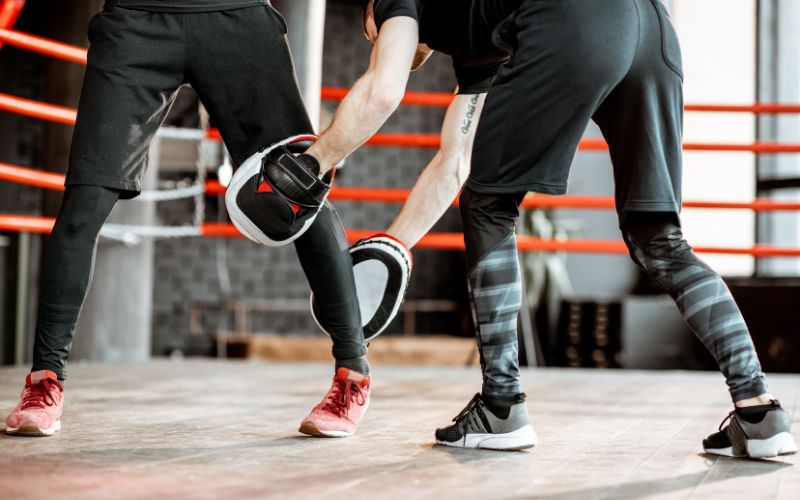Footwork is an essential aspect of boxing, requiring agility, speed, and balance. If you’re interested in learning boxing, developing good footwork is a critical first step.
Boxing footwork can take a few days to a few weeks to learn, depending on various factors such as natural athletic ability and dedication to training. Ongoing practice and refinement are necessary to become proficient in footwork, which requires agility, speed, and balance.
While there’s no hard-and-fast rule for how long it takes to learn boxing footwork, there are some general milestones that most people will hit along the way. In this section, we’ll explore what those milestones are and what you should focus on at each stage.
Timeline for Learning Footwork
Learning boxing footwork is a gradual process that involves building on basic techniques and gradually refining your movements. Here’s a rough timeline of what you can expect as you work to develop your footwork skills:
Basic footwork patterns and movements
When you’re first starting out with boxing footwork, you’ll begin by learning some of the basic patterns and movements. These movements are essential building blocks that will form the foundation of your footwork skills. Some of the key basic footwork patterns and movements include:
- Stepping forward with your lead foot: This movement is used when you’re moving toward your opponent to close the distance or set up a punch. Your lead foot will move forward while your rear foot follows suit.
- Stepping back with your rear foot: This movement is used when you’re moving away from your opponent to create space or avoid a punch. Your rear foot will move back while your lead foot follows suit.
- Side stepping to both sides: This involves moving laterally to the left or right, which can help you evade punches or create angles for your own punches. To side step, you’ll shift your weight onto the lead foot in the desired direction and move it. Then, you’ll bring your other foot over to meet it, so that you’re once again in a balanced stance. For example, if you want to step to your left, step with your left foot first, then your right.
- Pivoting: Pivoting is used to create angles and set up punches. You’ll rotate on the ball of your foot, turning your body to the side.
As for how long it typically takes to finish the basic footwork stage, this can vary depending on the individual. Most people can pick it up fairly quickly and move on to the next stage within a few days or even hours. It’s important to work at your own pace and focus on developing good habits and proper technique, rather than trying to rush through the learning process.
Developing agility and speed
Once you’ve mastered the basic footwork patterns and movements, you’ll begin working on developing more agility and speed. This stage is crucial for improving your footwork skills and becoming a more effective boxer. Here are some key things you can do to develop your agility and speed:
- Footwork Drills: footwork drills are an essential part of developing agility and speed. These drills are designed to challenge your footwork abilities and help you develop quick, precise movements.
- Footwork Games: playing games that involve quick footwork can also be a fun way to develop your agility and speed.
- Strength Training: building strength in your legs and core can also help improve your footwork.
How long this takes will depend on a number of factors, including your current level of fitness, your natural abilities, and how much time and effort you’re willing to put in. Some people may see significant improvement in their footwork skills within a few weeks, while others may take longer. The key is to stay dedicated and consistent with your training and focus on making incremental progress over time.
Refining footwork techniques
As you progress, you’ll start to refine your footwork techniques and work on incorporating them more seamlessly into your overall boxing game. This will involve things like:
- Using footwork to set up punches and create angles
- Incorporating footwork into defensive movements like slipping and rolling
- Developing more complex footwork patterns and movements, like the shuffle-step or the pivot-and-slide
At this stage, you’ll also be working on developing more endurance and stamina, as advanced footwork can be physically demanding.
Remember, everyone learns at their own pace, and there’s no one-size-fits-all timeline for mastering boxing footwork. However, by focusing on the basics, developing your speed and agility, and refining your techniques over time, you can become a skilled footwork practitioner and take your boxing skills to the next level.
After you’ve developed good agility and speed, the next step is to refine your footwork techniques. This stage involves working on more advanced footwork movements and combinations, and perfecting your form and timing. Here are some things that you’re going to do at this stage:
- Focus on Technique: as you work on more advanced footwork movements, it’s important to focus on your technique. Pay attention to your foot positioning, weight distribution, and balance, and make sure that your movements are smooth and efficient. If you’re not sure about your technique, consider working with a coach or trainer who can help you identify areas for improvement.
- Incorporate Combinations: once you’ve mastered individual footwork movements, try incorporating them into combinations. For example, you might practice stepping forward with your lead foot, pivoting to the side, and then stepping back with your rear foot. This can help you develop more fluid, dynamic footwork that can be used in the ring.
- Work on Timing and Rhythm: timing and rhythm are crucial components of effective footwork. Practice moving in sync with your punches and with your opponent’s movements, and focus on maintaining a steady pace and flow. Incorporating footwork drills that involve changing speeds or directions can also be helpful for developing good timing and rhythm.
- Consider Footwork Specific Training: there are also a variety of training tools and techniques that are specifically designed to help boxers improve their footwork. Some examples include agility cones, hurdles, footwork ladders, etc.
This stage will last as long as your boxing career, meaning you will never stop finding new ways to improve and work on your footwork. No matter how skilled you are, you can always get better. Never finished.

